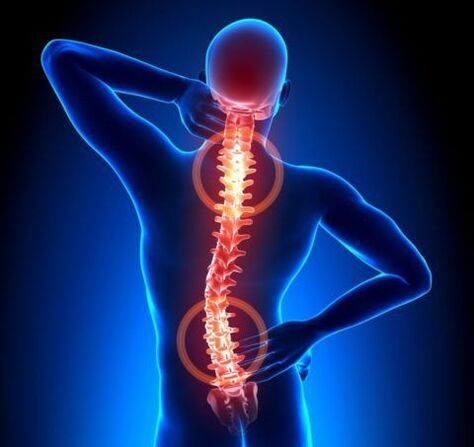
Many people between the ages of 30 and 35 complain about back pain.The cause of this pain can be the disease of the spine.Osteochondrosis is an illness that occurs in middle -aged people, but it is more common in patients after 40 years.
Osteochondrosis - what is this disease and what is your danger?
This term means a dystrophic process of cartilage and subject bone tissue.In modern medical practice, osteochondrosis is called degenerative dystrophic disease of the spine and the intervertebral disc that play the role of shock absorber.The risk of the disease is that the disk affected is almost impossible to restore, and disability is possible without proper treatment.
Osteochondrosis is a common disease?Statistics are not happy.About 85% of the world's population suffer from this disease.
This disease is the most common form among all diseases that affect the spine.And according to the prevalence, it is immediately according to diseases of the cardiovascular system.
The essence of the disease
So, osteochondrosis - what is it?This is a chronic disease that affects the joints, mostly the spine.
The spine consists of 24 vertebrae.There is a hard drive between the two vertebrae, the purpose of which is the softening and depreciation of loads.
In normal condition, the hard drive is quite elastic and can withstand significant loads.In the middle of the pane there is a cellar core with lots of water.For some reason, the core loses its hydrophilic properties.
As a result, the hard disk delay is reduced in height and deformation.In the later stages, the growth of the bone tissue occurs with the formation of growth sponsors - osteophytes that compress the peripheral nerves and the spinal cord.This is osteochondrosis of the spine.
The causes of pathology
Despite the fact that osteochondrosis is a rather common disease, the reasons why pathology develops is not fully established.
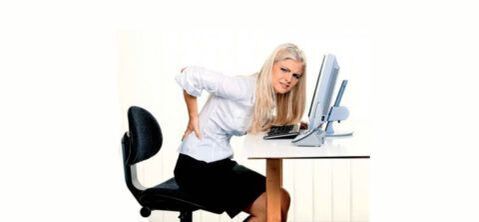
The main factors are taken into account:
- excessive stress on the spine;
- Injuries;
- Professional harmfulness - lifting weight or longer work in an unpleasant, motionless pose;
- excess body weight;
- Inheritance;
- Violation of attitude.
Osteochondrosis develops into one or the other degree in almost all people of older people and is one of the processes of aging the body.
Stadiums, shapes and symptoms of the development of the disease
Experts distinguish 4 stages of illness:
- 1. stage- move the core of the pane to the edge;
- Level 2- the occurrence of cracks in the bikes of the cartilage and the instability of the vertebral section;
- Level 3- a complete break of the disc with the loss of the core in the stem of the spine, while the roots of the spinal cord are possible;
- 4. Level- approximate changes not only in the intervertebral disc, but also in the surrounding fabrics.
The main symptom of the disease is pain.It can be acute with high intensity or stupid, moderate manifestation.
In addition to pain, there is:
- Painful tension of the back muscles;
- Daubiness of the skin on the arms and legs;
- Restriction of the movement volume;
- Weakness in the muscles of the limbs;
- Thinning of the arms and legs;
- Sudden dizziness.
These are general manifestations for all forms of pathology.Depending on the spine, in which changes are localized, three forms of the disease are differentiated with characteristic symptoms.
Table No. 1. Forms of osteochondrosis and their inherent symptoms:
| Form of the disease | Symptoms |
| Osteochondrosis in the neck | Changes in this department lead to blood vessels and impairment of microcirculation.For this reason, a person has constant dizziness.Sometimes this leads to fainting.In front of the eyes there are noises in the ears and flickering of colored spots. |
| Osteochondrosis in thoracic vertebrae | With this form of the disease, acute chest pain is observed.The disease can cause the advancement of the intercostal neuralgia and make the course of the heartfologies worse. |
| Osteochondrosis in the lumbar region | The pathology in the lower back is shown by pain in the buttocks region, a decrease in the sound of the IKR.A complication can be radiculite that is accompanied by pain that spreads into the leg. |
Due to the pathology of the vertebral discs, a large number of disorders occur in the body: clamping the nerves, swelling, circulatory injury and fibrosis of the surrounding tissue.These changes cause a variety of symptoms that make the diagnosis more difficult and examined the appropriate treatment without carefully.
Clinical manifestations
The symptoms of the disease depend on where the lesion is mainly.In the following sections we consider the signs for every variety of the disease.
The cervix department
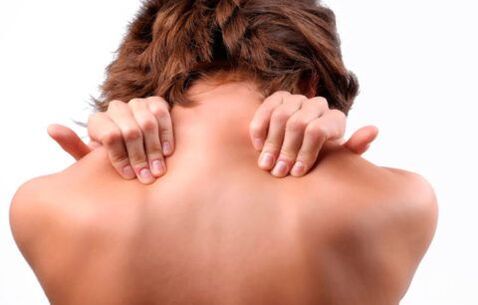
The main symptoms of damage to the cervical spine are:
- Complaints, pain in the neck and shoulders;
- Muscle hypotonus;
- increased sweating;
- Deafness of the fingers;
- Violation of the coordination of movements;
- Headache, dizziness;
- Problems with hearing and eyesight;
- Hypertension.
With the progress of the disease and damage to the nearby arteries and nerves, one of the following syndromes can develop:
- Arteria vertebrae;
- Heart;
- Hypertension;
- Root;
- Uterine migraine.
Violation of blood circulation in vertebral artery and this hypoxia of brain tissues are the dangerous consequences of osteochondrosis.
This syndrome manifests itself:
- System/periodic dizziness;
- Weakening of vision;
- partially or complete hearing loss;
- Sometimes - fainting.
Important!Neurological manifestations of osteochondrosis of the spine often have to differentiate with brain -atherosclerosis, dep and other pathologies.
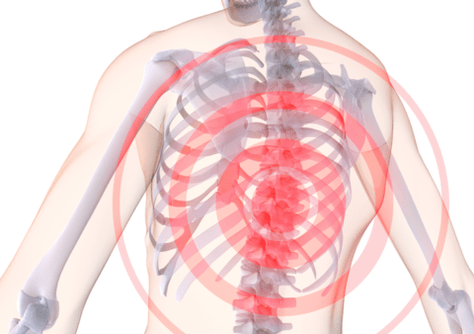
Thorax region
Compared to other forms of the disease, the thoraxosteochondrosis manifests itself less pronounced.
To his symptoms:
- Pain in the chest, at night or extended in one position;
- Complaints, a feeling of pressing between the shoulder blades;
- Strengthening the pain during deep breathing.
If the disease is not treated, it will progress and cause damage to the nearby nerves nearby.
Signs of the development of complications of osteochondrosis of the spine of this localization can be:
- Daubiness of the skin in some areas, a feeling of crawling "goosebumps";
- Itching, burning;
- Cooling of the limbs;
- Fragility of the nails;
- extremely dry skin;
- Pain along the esophagus and pharynx;
- Disruptions of the gastrointestinal tract.
In addition, the breast localization of the disease is characterized by two specific symptoms - dorsago and dorsalgy.
Dorsago is a sudden, sharp and very intense pain of the chest, a "breast shift".It can occur with a longer position, monotonous work.
Pay attention!During breastfeeding, the pain is so serious that the patients are afraid of taking additional breathing at all.
Doralgy is less intense, but monotonous painful sensations that can take up to 2-3 weeks.They intensify with deep breathing, tendencies.
Lumbar department
Osteochondrosis of the lower part of the spine, namely the lumbar spine, occupies a leading position on prevalence.
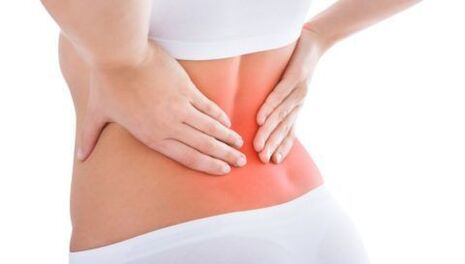
To his characteristic symptoms:
- blunt, frequent painful pain in the lower back, radiates in the leg;
- Complaints, intensify when you change the position of the body, sneeze, cough, lift weights;
- constant muscle cramp in the lower back;
- Lights in the lower back;
- Impaired sensitivity on the skin of buttocks, hips, legs, feet;
- A feeling of goosebumps on the lower extremities;
- Dry, peel the skin.
The sacred department
Osteochondrosis of the sacred spine is extremely rare in isolated way and is usually a "continued" of the lower lumbar damage.
This explains the characteristics of his symptoms:
- Pain in the lower back and nerve compression;
- Sharp "shelters" through the entire leg;
- an uncomfortable feeling of discomfort in the back of the thigh;
- Dustiness of the lower extremity;
- Parese as well as unstable symptoms of impaired motor activity.
Important!Osteochondrosis of the lower spine can lead to extremely dangerous complications such as an impaired blood supply to the spinal cord and compression myelopathy.
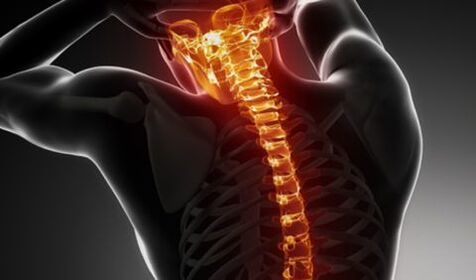
Frequent osteochondrosis
A common form or osteochondrosis of all parts of the spine is the most serious version of the pathology.Due to the width of the defeat, its image can be extremely different and almost all of the symptoms described above include.
Diagnostic methods
The appearance given from above requires an appeal to a medical facility: the patient must examine the patient.The diagnosis of osteochondrosis should be complex and very thorough.
The standard instructions contain the following phases:
- Collection of complaints and anamnesis.
- Clinical inspection.
- X -Ray test.
- Modern methods (CT, MRI).
The doctor should have a conversation with the patient and find out:
- what disturbs the patient;
- What is the place of the most pronounced unpleasant sensations;
- What is their intensity and duration;
- which provokes their strengthening;
- What helps to get ready with pain.
Important!Be sure to tell the doctor how long you are concerned about such symptoms and whether you received treatment earlier.
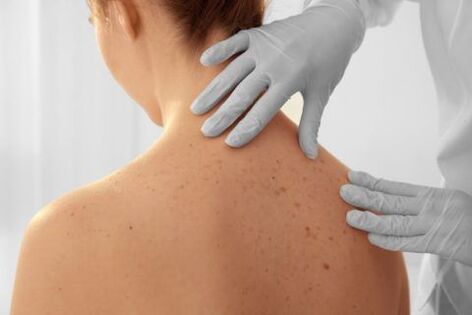
During a clinical inspection, the specialist evaluates:
- the position of the patient's body, gear, the volume of active and passive movements;
- the presence of skin defects, redness, peel;
- Symmetry of healthy and sick parts of the body;
- the presence of muscle cramp;
- The area of radiation of pain;
- The presence of pain, temperature and other types of sensitivity.
During radiography, each spine is examined individually for better visualization.Images are listed in direct, lateral and (according to information) of two sloping projections.In order to evaluate the stage and the severity of the degenerative-dystrophic changes, the X-ray classification of the osteochondrosis of the spine of the zeaker is used.
Table: X radiation stages of osteochondrosis of the spine:
| stage | Description |
| I (+) | Unspoken changes in the lordosis in a small number of segments |
| II (++) |
|
| III (+++) | Printed changes, significant narrowing of the band's holes |
| IV (++++) | Significant narrowing of the volunteer holes, massive exostosis, often irreversible changes |
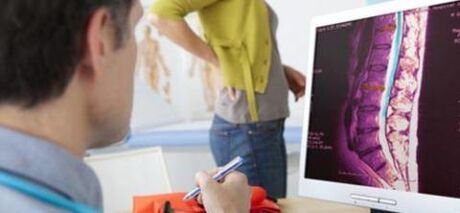
With inadequate information content of the R-impicture, more modern tests (targeted images of one or more segments of the spine) and the MRI (visual diagnostic method based on the properties of electromagnetic radiation) can be prescribed to the patient.
Treatment
First of all, the doctor explains to the patient what osteochondrosis is and how to treat them.He talks about a number of measures that have to be carried out for a long period of time.
The disease is therapy taking into account the stage.In the early days of the disease, massage, physiotherapy, physiotherapy exercises are indicated.In the course of the dystrophic process, however, various orthopedic devices should be used to immobilize the spine.Medicinal treatment is also necessary.
Surgical intervention is displayed through complications and the ineffectiveness of conservative treatment.
Medication
The most important treatment tasks with pharmacological drugs are the relief of pain, the elimination of the inflammation of nerve roots, the restoration of the structure of the cartilage, the improvement of blood circulation and nutrition, the impairment of the development of pathology.In this case there are several drug groups that can be prescribed.
In pharmacies they are represented in different forms and in a large variety.The price of medication can vary and you can always choose the cheapest.
Table No. 2. Medicines used for conservative therapy for osteochondrosis:
| Pharmacological group | Therapeutic effect | Instructions for use |
| Chondroprotectors | Slow the degeneration processes of the cartilage and contribute to recovery. | Take 1 capsule for a month.If necessary, the course of treatment is repeated. |
| NSAID | It has an anesthetic effect, reduces the inflammatory process. | Take a tablet for pain.In the event of severe pain, intramuscular injections of the drug are used. |
| B vitamins | Improves the conductivity of the nerve impulse and restores the microcirculation in the area of the affected cartilage. | Treatment with intramuscular injections is carried out. |
| Musorelaxants | Relaxed the muscles, relieves the tension, relieves pain. | Take a tablet twice a day. |
Medicines are prescribed according to the doctor.Self -medication can be ineffective and in some cases even damage.
Physiotherapy for osteochondrosis
What to do with osteochondrosis besides medication to accelerate recovery?One of the most effective methods for the treatment of this disease is physiotherapy.
Its advantage is a selective effect on the focus of the disease.Physiotherapy contributions to reduce pain, to eliminate inflammation and increase general immunity.With their help, the muscles, metabolic processes and blood circulation are normalized.
They are successfully used for osteochondrosis:
- Magnetotherapy;
- Laser therapy;
- Shock wave therapy;
- Quartz;
- Electrophoresis;
- The effect of electrical currents with a low frequency.
Physiotherapy is not carried out when the patient is in a serious state, with a deterioration in the disease, oncological diseases and mental disorders.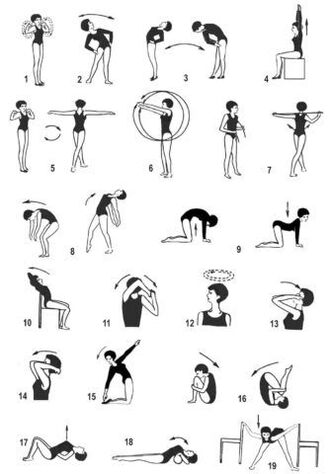 In other cases, physiotherapy has an advantageous influence on the recovery process and improves the effect of medicinal products, which reduces its dosage.
In other cases, physiotherapy has an advantageous influence on the recovery process and improves the effect of medicinal products, which reduces its dosage.
Medical physical education
Sports lessons are prohibited in the acute time of the disease.After the doctor has eliminated this time, he prescribes therapeutic exercises that he developed individually for each patient together with the trainer.
With the help of exercises, the sore muscles are reinforced, which prevents the curvature of the spine and can distribute the load on the vertebrae correctly and evenly.With regular physical exertion, medical substances penetrate the spine in higher concentrations than in their absence.
It is necessary to operate the instructions of an experienced instructor and carefully monitor its condition.The exercise should be stopped in the event of complaints and severe pain.
prevention
Knowing what osteochondrosis is and its consequences will be useful to think about prevention.
Preventive measures are quite simple, for everyone who takes care of their health, they are easy to carry out:
- Prevention of injuries;
- Regular physical training (swimming is very useful);
- maintain normal weight;
- Don't load the spine;
- Monitor the correctness of the attitude;
- not in a position for a long time;
- Avoid sudden movements when lifting weights.
The remission time takes long when these rules are fulfilled.
Osteochondrosis is a fairly serious disease.But with the timely search for a doctor and adequate treatment, it is possible to stop its destructive effect.
Questions to the doctor
Neck pain
Hello, please tell me.I am 24 years old.In the past few months, the pain in the neck, in the back of the head (sometimes still the whiskey, the eyes).I also notice a strong crunch in the neck, tingling and numbness of hands, tongues and sky.
I suspect osteochondrosis because both mom and grandmother are tortured with similar symptoms.Where can you start the exam?And another question: can I go to aerobics?
Make an R -scheme (CT) shop and a Doppler of the vessels of the head and neck.You have probably developed the syndrome of vertebral artery against the background of the cervix osteochondrosis.Another plan for diagnosis and treatment can only be created after receiving the results of these tests.
It is better not to visit aerobics yet.
Lumbale osteochondrosis
I have been tortured with the lower back for seven years, the tightening of the osteochondrosis is almost every 2-3 months.Injections and tablets help for a short time and then the pain returns.I work as a postman, it will be more difficult.Am I disabilities?
Hello!The ITU is decided to award the Disability Group on the basis of a comprehensive examination of its situation.First you have to contact the therapist and undergo an exam.
As a rule, a group of disabled people is not shown in the case of lumbar osteochondrosis.Its award is possible with the development of complications (conditions, intermediate ernia, etc.).But again I repeat that everything is individual here.



























